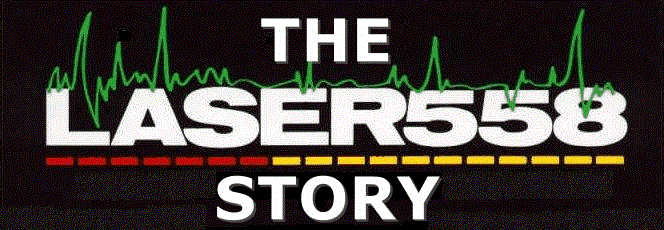During the sixties the offshore stations had enjoyed massive audiences, with Radio Caroline and Radio London each having more than eight million listeners. During the seventies Caroline, Northsea and
Atlantis all had their fans but, for different reasons, never quite managed to attract the big numbers. It wasn't until the eighties, with the arrival of Laser-558, that offshore radio really captured the public imagination again.
An all hit format with a minimum of interruptions and a team of professional American disc jockeys quickly won a massive audience, but very little was known about the station. Where had it come from? Who was behind it?
Because of the American voices heard on air, and the New York mailing address, it was generally assumed that the station was US-owned but in fact the main man was much closer to home. He was Dublin hotelier Philip
Smyth.
|
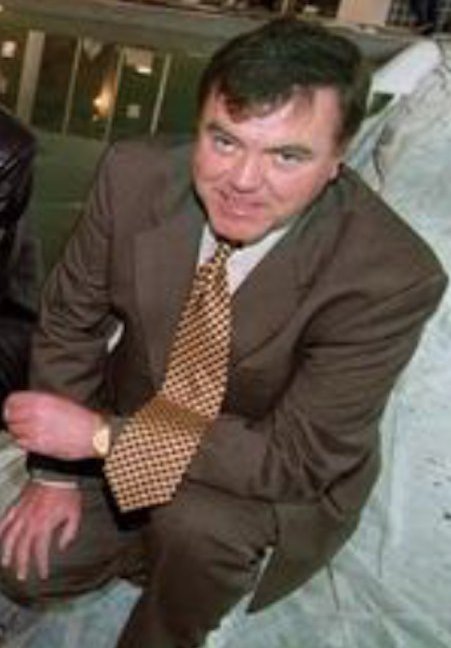
|
|
Philip Smyth. A photo shared on Facebook by Paul Rusling.
|
Some years earlier Smyth had been approached by Chris Cary when he was looking for investors for the launch of Radio Nova, the Dublin land-based pirate. Smyth had hesitated, and missed his
chance to become involved with one of the most successful stations of the era. Annoyed with himself, he decided that maybe he should launch a radio station of his own.
On a skiing holiday in Les Arcs, France, a few months later, Smyth met a disc-jockey called John Kenning. He was working on Radio Arc, a local station which broadcast to the resort. The two hit it off and stayed in touch after the
holiday.
They met up again back in Les Arcs the following year, 1982. Writing about it on Bob LeRoi's website (archived here) John remembered: “I
told Smyth about an idea that I'd had for a North Sea radio project. I outlined it as simply as possible, as a radio ship broadcasting from the North Sea. Laser zaps in between records would be used as an audio tool to enable
listeners to easily identify the station. To get around the Marine Offences Act, it would be staffed by American jocks and the station would be modelled on my all-time favourite pirate: Swinging Radio England. OK, it was a great
dream, but by the time we had skied down the mountain, to my utter amazement, Smyth wanted to know more. By the end of the holiday, he was totally sold on the idea. Smyth had missed out on Nova, but this time he wasn't going to
miss his chance!”
Smyth brought BBC journalist Roger Parry on board and, after asking around about who could provide technical knowledge, Kenning contacted Paul Rusling who had previously worked for Radio Caroline.
Rusling also suggested that Howard Rose (aka disc jockey Crispian St.John) would be a good addition to the team.
Kenning and Rusling went to the States to source equipment and to find an executive to head the sales team. They selected Roy Lindau, an American advertising man from New York's Major Market Radio agency. Talks continued but when
they appeared to be going nowhere, Kenning and Rose decided to leave the project and set up something of their own. They launched the south London land-based oldies pirate Radio Sovereign.
|
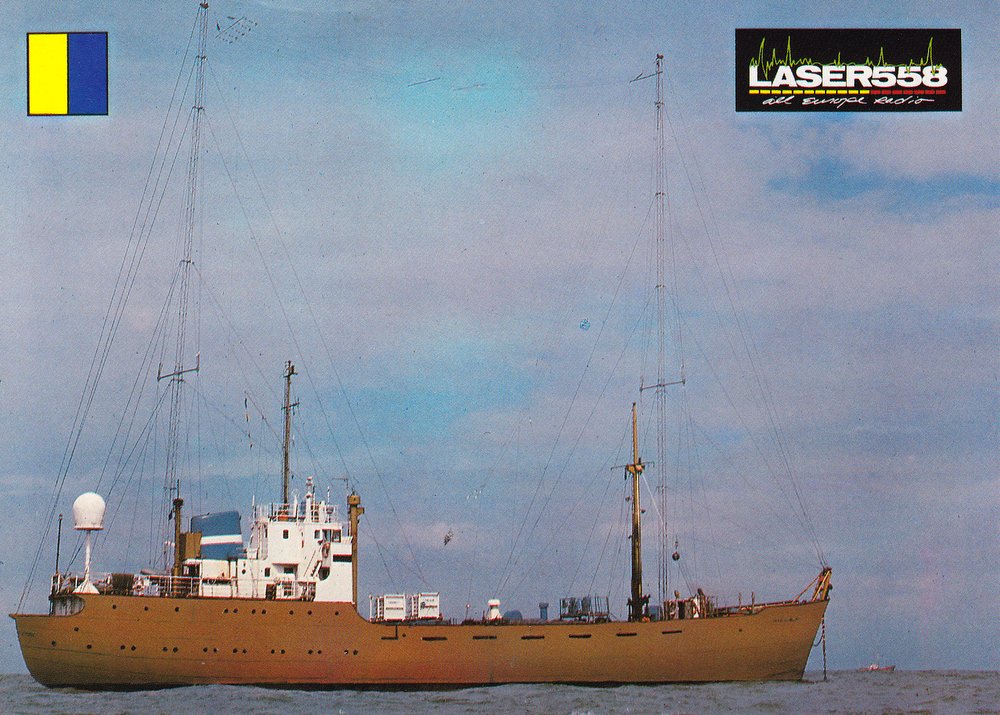
|
|
The mv Communicator. A Laser promotional postcard.
|
Lindau had previously been involved with Radio Caroline's plans to return from their new ship, the Ross Revenge, but had fallen out with owner Ronan O'Rahilly. He was still fascinated
by the potential for European offshore radio. Initially the plan was for two stations, Laser (employing a Hot Hits format and originally to be called Radio Star) and Radio Waves which would operate a gold playlist. They would be
all-foreign, owned by a Panamanian corporation and operated by Americans. It would be totally legal as there would be no Britons breaking the Marine Offences Act. That was the long-term plan but, in the meantime, the very British
Paul Rusling was employed to help find a suitable vessel.
The Gardline Seeker had been working as a survey ship but had been built, in 1954 in West Germany, as a cargo vessel. And she was for sale. A deal was completed and, in August 1983, she left Lowestoft harbour for America. In the
meantime the corporate structure was worked out. Music Media International of New York was to be the sales company, run by Lindau, while the ship was owned by Deka Overseas Inc.. By the time the ship arrived in Tracor Marine shipyard
Port Everglades Florida in September she had become the mv Communicator, flying the Panamanian flag.
Equipment for three studios and four transmitters was ordered for the two stations but, in the event, the backer for the oldies station pulled out and two of the transmitters were never installed. Similarly the third studio was not
built but two were - and very good ones they were too. No expense was spared on the ship's refitting. An exotic $11,000 fire-fighting device and a super-sophisticated anchorage system were ordered. All the most modern state-of-the-art
technology was used. The ship was even equipped with a satellite receiving antenna dish so that the crew could be in direct contact with the New York office. The plan was that news bulletins, telexes, advertisements and possibly even
music would be beamed directly to the North Sea from the States. Another break with tradition was that the music was to be played almost entirely from tape cartridges rather than vinyl records. It was even decided to experiment with
an unusual aerial system. Traditionally pirate ships broadcasting on AM have utilised large masts to hold up their aerials. However having to keep the ship stable puts a restriction on the maximum possible mast height. Laser hoped that
using a helium balloon instead to hold up their antenna, it could be raised to a massive 350 feet. It was a daring, some might say foolhardy, decision and with the benefit of hind-sight, a costly mistake.
|
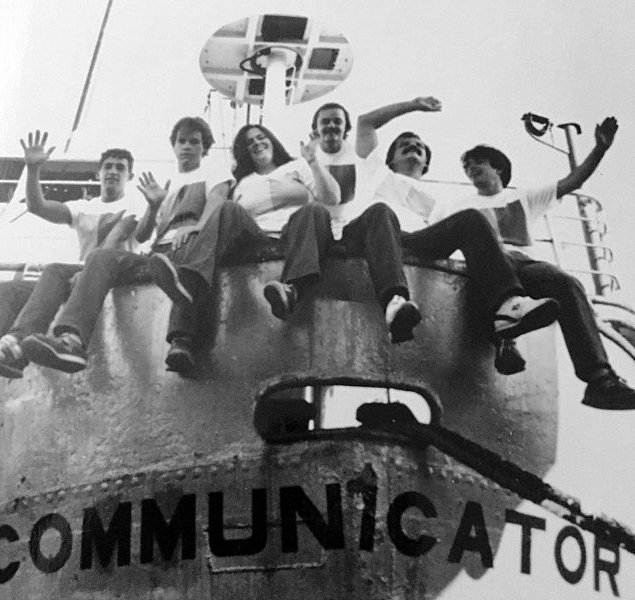
|
|
Some of the original Laser DJ line-up, a photo taken after they had filmed a promotional video in Miami harbour. Left to right: Steve Masters, David Lee Stone, Jessie Brandon, Captain Buzz Cody, Mighty Joe Young and Ric
Harris. Masters and Cody quit the project before the station properly launched. Photo courtesy of Michael Dean. There are more of his pics here.
|
In all some £1,250,000 was said to have been invested in Laser. Work continued in secrecy until November 1983 when the Communicator left Florida for her British anchorage, calling on the way at The Azores
and Ireland. A full DJ complement was aboard (David Lee Stone, Ric Harris, Jessie Brandon, Melinda Clare, Captain Buzz Cody, Steve
Masters, Mighty Joe Young and Blake Williams. The last two were also engineers). The first test broadcast actually went out while the ship was in New Ross harbour
Ireland on 17th December, lasting just a few minutes. Later that week the ship arrived in the Thames estuary. A fierce storm forced her to move to a position off Margate. Rumours that the authorities were taking an interest made
another move essential, this time into international waters.
At the end of December 1983 the Communicator dropped anchor a couple of miles south of the Ross Revenge in the Knock Deep Channel of the North Sea. This other ship was the new home of Radio Caroline.
The station had returned to the air in August and, after a shaky start, was beginning to re-establish itself.
On 19th January 1984 the Laser engineers and crew erected the aerial system for the first time. The large silver and red TRF (Tethered Rigid Fin) balloon went up, attached to the antenna by a length of strong nylon cord. The balloon
rose to its full 350ft. and the transmitter was switched on. Everything seemed to work, so power was increased. But no programme was broadcast because, after only five minutes, the power emanating from the aerial caused the air
around it to ionise and heat up. No insulators had been fitted and the radiating heat melted the nylon rope. The aerial collapsed as the $11,000 balloon floated away.
|
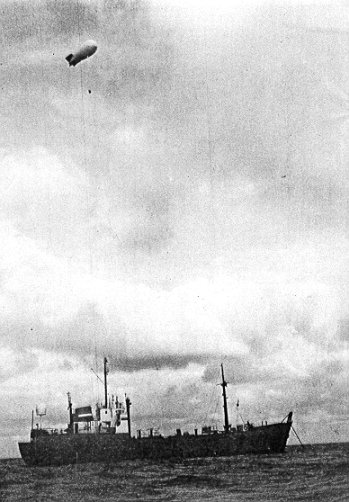
|
|
The mv Communicator with its balloon aerial. Photo from Offshore Echos magazine.
|
On Saturday 21st another attempt was made using the spare balloon. This time a sheet of galvanised sheet metal was fitted as a corona shield to prevent the ionisation but things still didn't go to plan.
The device was being stabilised by two guy ropes when one of them snapped. This caused the other one to whip out of someone's hands. Fortunately the balloon did not escape this time but ended up being retained just by the
antenna itself with no stabilising guy ropes. It was up, even if not properly tethered, so the engineers decided to go ahead with the test broadcast.
There was an ironic choice of first track: a clip of Led Zeppelin's Communication Breakdown. This was followed by non-stop Beatles music on 729 kHz, 411 metres. No station
identification was broadcast, in fact no speech at all. The transmitter was running at a power of about 5 kW and a moderate signal resulted. Unfortunately 729 kHz was not a good choice of frequency. Right next to it on the dial, on
720 kHz, was BBC Radio Four's London AM outlet. Interference was inevitable. Despite the unsuitability of the frequency the quality of the signal was reassuring and the tests continued into the early hours of 22nd January. By this
time a force 9 gale had developed. Just after 2am the second balloon blew away, the aerial collapsed and Laser was silenced. One of the escaped balloons was reported to have landed on a traffic roundabout in Colchester while the
other was said to have come to rest on a Belgian church steeple.
 Non-stop Beatles music being played on a test transmission from Laser 730 on 21st January 1984. This clip is taken from a recording shared on The Offshore Radio Club Forum
by Hans Hendriks. Our thanks to him (duration 1 minute 43 seconds)
Non-stop Beatles music being played on a test transmission from Laser 730 on 21st January 1984. This clip is taken from a recording shared on The Offshore Radio Club Forum
by Hans Hendriks. Our thanks to him (duration 1 minute 43 seconds)
After months of pouring money into the project Philip Smyth decided that enough was enough. There would be no more. He went off on another skiing holiday. Roy Lindau had spent the entire budget. The American
crew members were told to come home.
Many thanks to Radio Adventures of the mv Communicator and The Lid Off Laser 558, both by Paul Rusling, Laser 558: All Europe Radio by Hans Knot, Monitor magazine and
Offshore Echos.
Part two over the page.
|

